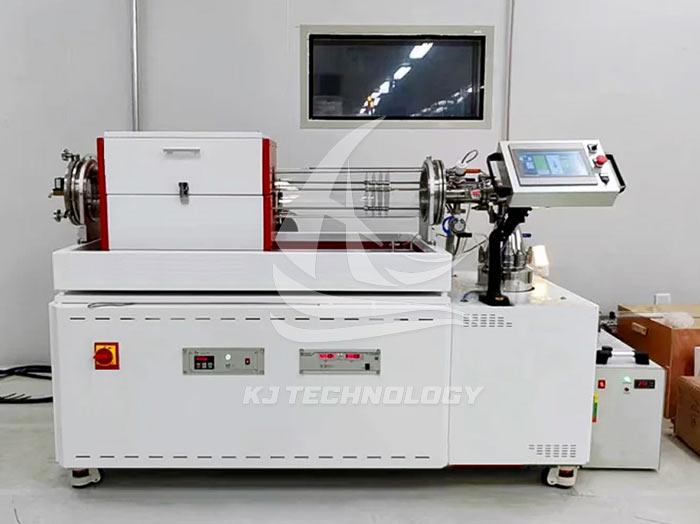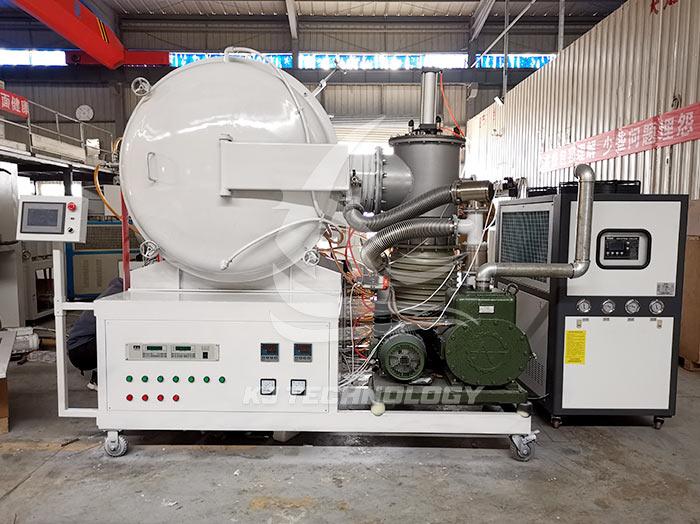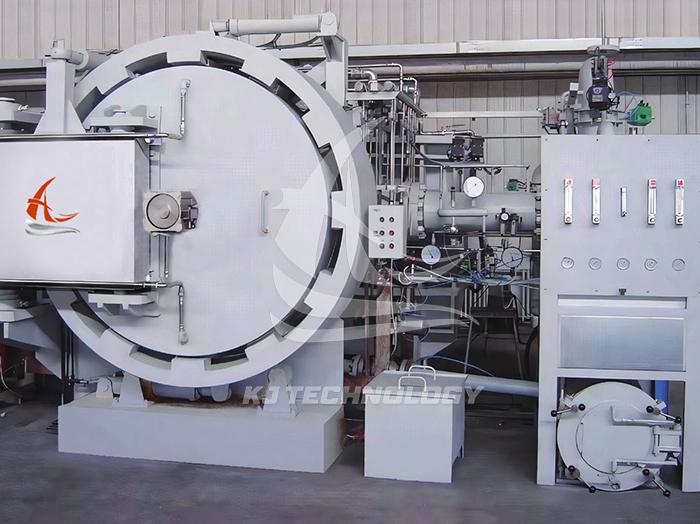What are the characteristics and advantages of metal material vacuum sintering furnaces?
 06-20-2025 Author: KJ technology
06-20-2025 Author: KJ technology
The metal material vacuum sintering furnace significantly improves material properties and process stability by subjecting metal materials to high-temperature treatment under vacuum or inert atmosphere. The following is a detailed explanation of its core features and advantages:
1. Core Features
High vacuum environment control
Extreme vacuum degree: up to 10 ⁻³ Pa or even higher (such as 10 ⁻⁴ Pa), effectively isolating active gases such as oxygen and nitrogen, avoiding material oxidation or nitridation.
Application scenario: Suitable for sintering easily oxidizable metals such as titanium alloys and tungsten molybdenum alloys, ensuring material purity.
Accurate temperature control
Temperature range: typically from room temperature to 2200 ℃, with some high-end devices reaching up to 2600 ℃.
Temperature control accuracy: within ± 1 ℃, meeting high-precision sintering requirements (such as densification of hard alloy cutting tools).
Heating method: resistance heating, induction heating or microwave heating, with uniformity better than ± 5 ℃ (temperature difference inside the furnace).
Atmosphere protection flexibility
Vacuum/Inert Gas Dual Mode: Supports pure vacuum sintering or filling with inert gases such as argon and nitrogen to meet different process requirements.
Gas flow control: The mass flow meter accurately adjusts the gas ratio (such as Ar+H ₂ mixed gas) to achieve reducing atmosphere sintering.
Structural Design and Material Optimization
Furnace material: Adopting a double-layer water-cooled stainless steel structure, lined with high-purity graphite or ceramic fibers, it has high temperature resistance and excellent thermal insulation performance.
Sealing technology: Metal sealing ring or rubber sealing ring (metal sealing is used in high temperature sections) to ensure long-term operation without leakage.
Heating element: graphite heater or molybdenum heater, suitable for high temperature and reducing atmosphere.
Automation and Security Systems
PLC control system: realizes automatic control of temperature, vacuum degree, and gas flow rate, and supports process curve programming.
Safety protection: equipped with over temperature alarm, leakage protection, water pressure monitoring, gas leakage alarm and other devices to ensure safe operation.
2. Core advantages
Improve material performance
High density: The vacuum environment reduces gas pores, and the material density can reach over 99% (such as hard alloy density ≥ 14.5 g/cm ³).
Excellent mechanical properties: After sintering, the hardness, strength, and wear resistance of the material are significantly improved (such as tungsten steel hardness reaching HRC 90 or above).
Microstructure optimization: Uniform grain growth and phase distribution, reducing defects such as cracks and segregation.
Process stability and repeatability
Parameter consistency: Precise temperature control and vacuum degree control ensure consistent performance of different batches of products (such as sintering shrinkage fluctuation ≤ 0.5%).
Low pollution risk: Vacuum environment avoids the introduction of impurities and is suitable for high-purity material preparation (such as semiconductor target materials).
lower production cost
Reduce scrap rate: High success rate (≥ 98%) reduces material waste.
Energy saving design: efficient insulation layer and rapid cooling system shorten the sintering cycle (such as traditional sintering 10 hours vs vacuum sintering 6 hours).
Extend equipment lifespan: Water cooling system and high-quality materials reduce maintenance costs.
Adapt to complex process requirements
Multi stage sintering: supports segmented control of heating, insulation, and cooling to meet the requirements of gradient material preparation.
Pressure sintering (optional): Combined with hot isostatic pressing (HIP) technology, further enhance the density of materials (such as powder metallurgy turbine disks).
Special atmosphere treatment: such as hydrogen reduction atmosphere sintering, used for metal purification or carbide synthesis.
Environmental and safety advantages
Non polluting emissions: The vacuum environment avoids the release of harmful gases and meets environmental protection requirements.
Operational safety: Fully enclosed furnace body and multiple safety interlocking devices reduce the risk of accidents.
3. Typical application cases
carbide tool
Process: Vacuum sintering (1450 ℃)+rapid cooling.
Effect: Hardness HRC 92, flexural strength ≥ 3000 MPa, lifespan increased by 30%.
Aerospace high-temperature alloys
Process: Vacuum induction sintering (1600 ℃)+hot isostatic pressing.
Effect: Density of 99.8%, high temperature strength (1000 ℃) ≥ 800 MPa.
Semiconductor target material
Process: Ultra high vacuum sintering (1800 ℃).
Effect: Purity 99.999%, uniform grain size (≤ 50 μ m).
Tungsten molybdenum parts
Process: Hydrogen reduction atmosphere sintering (2000 ℃).
Effect: Density of 19.3 g/cm ³, conductivity ≥ 50 MS/m.
Suggestion for selection:
Priority vacuum sintering furnace: If the material is prone to oxidation and requires high purity or high density (such as aerospace, semiconductor).
Traditional atmosphere furnace: suitable for conventional sintering of low-cost, non reactive metals (such as ordinary steel parts).
4. Summary
The metal material vacuum sintering furnace significantly improves material properties and process stability through high vacuum environment, precise temperature control, and flexible atmosphere control, especially suitable for the preparation of high value-added materials. Its core advantages include:
Material performance improvement (high density, excellent mechanical properties);
Process stability (consistent parameters, low scrap rate);
Cost effectiveness (energy-saving, long lifespan);
Environmental protection and safety (pollution-free, safe operation).
In the high-end manufacturing field, vacuum sintering furnaces have become an indispensable key equipment, and their technological upgrades will further promote breakthroughs in material properties.








